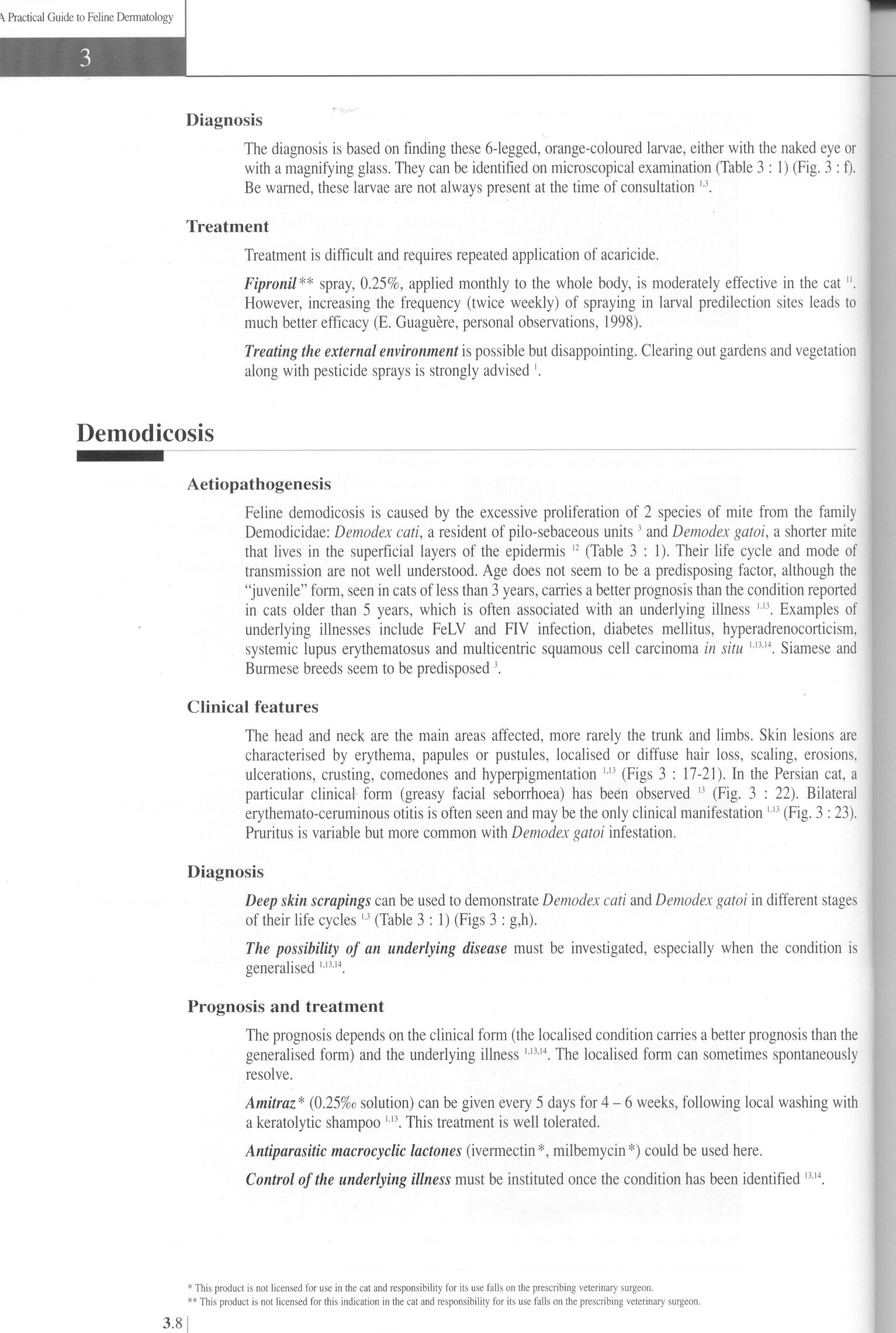37 (248)

3
\ Practical Guide to Feline Dermatology
Diagnosis
The diagnosis is based on finding these 6-legged, orange-coloured larvae, either with the naked eye or with a magnifying glass. They can be identified on microscopical examination (Table 3:1) (Fig. 3 : f). Be wamed, these larvae are not always present at the time of consultation u.
Treatment
Treatment is difficult and reąuires repeated application of acaricide.
Fipronil** spray, 0.25%, applied monthly to the whole body, is moderately effective in the cat". However, increasing the freąuency (twice weekly) of spraying in larval predilection sites leads to much better efficacy (E. Guaguere, personal observations, 1998).
Treating the external environment is possible but disappointing. Clearing out gardens and vegetation along with pesticide sprays is strongly advised '.
Demodicosis
Aetiopathogenesis
Feline demodicosis is caused by the excessive proliferation of 2 species of mite from the family Demodicidae: Demodex cati, a resident of pilo-sebaceous units3 and Demodex gatoi, a shorter mite that lives in the superficial layers of the epidermis 12 (Table 3:1). Their life cycle and modę of transmission are not well understood. Age does not seem to be a predisposing factor, although the “juvenile” form, seen in cats of less than 3 years, carries a better prognosis than the condition reported in cats older than 5 years, which is often associated with an underlying illness W3. Examples of underlying illnesses include FeLV and FIV infection, diabetes mellitus, hyperadrenocorticism, systemie lupus erythematosus and multicentric sąuamous celi carcinoma in situ U3'14. Siamese and Burmese breeds seem to be predisposed3.
Clinical features
The head and neck are the main areas affected, morę rarely the trunk and limbs. Skin lesions are characterised by erythema, papules or pustules, localised or diffuse hair loss, scaling, erosions, uleerations, crusting, comedones and hyperpigmentation u3 (Figs 3 : 17-21). In the Persian cat, a particular clinical form (greasy facial seborrhoea) has been observed 13 (Fig. 3 : 22). Bilateral erythemato-ceruminous otitis is often seen and may be the only clinical manifestation 113 (Fig. 3 : 23). Pruritus is variable but morę common with Demodex gatoi infestation.
Diagnosis
Deep skin scrapings can be used to demonstrate Demodex cati and Demodex gatoi in different stages of their life cycles13 (Table 3:1) (Figs 3 : g,h).
The possibility of an underlying disease must be investigated, especially when the condition is generalised U3,14.
Prognosis and treatment
The prognosis depends on the clinical form (the localised condition carries a better prognosis than the generalised form) and the underlying illnessl l314. The localised form can sometimes spontaneously resolve.
Amitraz* (0.25%o solution) can be given every 5 days for 4 - 6 weeks, following local washing with a keratolytic shampoo u3. This treatment is well tolerated.
Antiparasitic macrocyclic lactones (ivermectin*, milbemycin*) could be used here.
Control of the underlying illness must be instituted once the condition has been identified ,314.
* This product is not licensed for use in the cat and responsibility for its use falls on the prescribing veterinary surgeon.
** This product is not licensed for this indication in the cat and responsibility for its use falls on the prescribing veterinary surgeon.
3.8
Wyszukiwarka
Podobne podstrony:
69 (119) 6 A Practical Guide to Feline DermatologyDiagnosis The diagnosis is based on lesion distrib
313 (14) A Practical Guide to Feline Dermatology The second phase consists of long-term control of t
44 (228) 4 A Practical Guide to Feline Dermatolog) The term “asymptomatically infected cat” refers
248 (22) 24 A Practical Guide to Feline DermatologyDiagnostic tests Given the incidence of dermatoph
58 (148) 5 A Practical Guide to Feline Dermatology severity of the illness. High titres are seen wit
28 (374) 2 A Practical Guide to Feline Dermatology Configuration of lesions Determining the configur
82 (128) 8 A Practical Guide to Feline Dermatology considered important parasites. Cats in the Unite
42 (226) 4 A Practical Guide to Feline Dermatology Increased hydration and subsequent maceration of
54 (167) 5 A Practical Guide to Feline DermatologyClinical features The disease can present in three
35 (267) A Practical Guide to Feline Dermatology 1 3 Table 3:1: Identification of the principal
236 (22) Practical Guide to Feline Dermatology23 observed on the whole body. Nodular lesions primari
65 (127) 6 A Practical Guide to Feline Dermatology Other topical antimicrobial agents, such as chlor
67 (125) 6 A Practical Guide to Feline DermatologyNocardiosisAetiopathogenesis Nocardiosis is a very
710 (2) 7 A Practical Guide to Feline DermatologyHerpesvirus infections Dermatological manifestation
74 (105) 7 A Practical Guide to Feline Dermatology ulcerated. Lesion distribution is multicentric bu
27 A Practical Guide to Feline Dermatology Perianal glands 1.7 Permethrin 3.12, 3.13 Persian 1.6,2.2
27 A Practical Guide to Feline Dermatology Stemphyllium spp. 5.1,7.8 Stereotypie behaviour 17.1,
272 (16) 27 A Practical Guide to Feline Dermatology Alternaria spp. 5.1,7.8 Aluminium hyroxide 15.6&
274 (18) 27 A Practical Guide to Feline Dermatology Colitis 11.2 Collagen 1.2,2.6,12.1,
więcej podobnych podstron